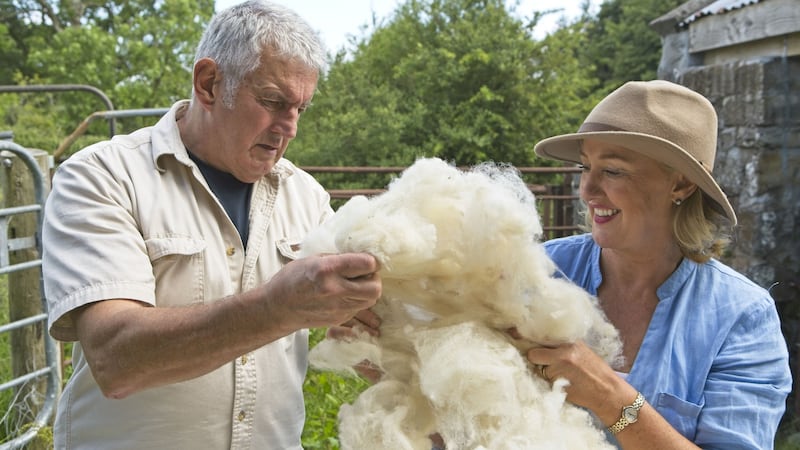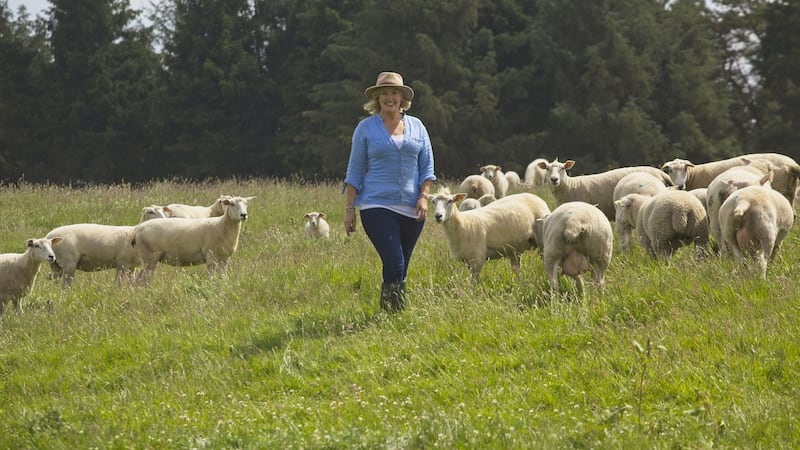“Welcome to Athenry – are you on holiday?” queried the kindly shopkeeper in the lovely medieval Galway town in June. “No, I’m going to the mart,” I replied. “The mart? The mart? Are you thinking of buying a few sheep? Have you got a bit of land?” he inquired, curious. “No, I’m going to the launch of Galway Wool.” “Oh!” End of conversation. But of that, more later.
While we are talking about wool, what is an Irish sweater? Many of the woollen ones we see in Irish shops claiming Irish provenance are made in China, India, Morocco, Turkey and other countries produced from imported yarns – just examine the labels.
Yet in this country we have more than three million sheep whose fleeces are considered waste and worthless because farmers breed sheep for meat and not wool. A high-value product has become a low-value one, according to wool merchant Kevin Dooley. And what farmers are paid for their fleeces hardly covers the cost of shearing.
Here and abroad, that iconic emblem of Ireland, the Aran sweater, continues to thrive in various iterations (we are always seeing celebrity images – memorably Taylor Swift, Chris Evans, not to speak of Adam Driver, in the forthcoming House of Gucci movie) while Irish wool production is on its knees and Irish sheep farmers expected to dump their wool again this year.
Passionate and dynamic
One pioneering Irish woman, the passionate and dynamic Blatnaid Gallagher from Galway is on a mission to change all that. She has turned her experience as the Reserve Defence Force’s first woman logistics officer and truck driver instructor, to achieving recognition for the crisp, snow white wool of the native Galway sheep with its medium to fine texture and lustre.
There’s no pulling wool over this woman’s eyes. It was at the aforementioned Athenry Mart where her pioneering venture, the Galway Wool brand, was officially launched with some ceremony at a Wool Meitheal attended by farmers, musicians, sheep shearers, local officials, weavers and others.
Gallagher hails from an agricultural background. She was one of the first area female managers for Novartis, later running her own restaurant and cafe in Oranmore and more recently completing a masters in Agricultural Innovation at NUIG during lockdown “when everyone else was clearing out their wardrobes”, she says wryly. Her interest in Galway sheep developed when she inherited a farm of 100 acres in Ballinasloe from her uncle six years ago.

“The Galway is Ireland’s oldest sheep breed and it is from her wool that the Aran sweater was created,” she explains. “Before the introduction of European and British breeds like Suffolk, Texel and Charolais in the ’60s and ’70s when the entire flock was lowland Galway, Irish farmers were successful in earning a living from this placid, dual-purpose sheep. But consumer demand for softer wool led to merino and the move away from Irish wool which then lost its ability to market itself for its sustainability and traceability qualities for fashion, lifestyle and interior products.
While Gallagher bemoans the lack of State support for wool producers, it must be noted that Green Party Minister of State Pippa Hackett, as a sheep farmer herself, is aware of industry problems. Her wool feasibility group will report in November on alternative uses of wool.
Galway Wool Co-op
Gallagher and a group of Irish farmers have formed the Galway Wool Co-op with other members of the Galway Sheep Breeders Society and set up their own brand, “a heritage product from a flock that is 100 years old”. The co-op comprises some 60 flocks around Ireland ranging from five to 80 sheep “with full-time farmers, part-time farmers, heritage farmers and even a gentleman farmer from Rathgar”, she says. “I have 40 pure-bred registered ewes and their wool will never be merino, but if it blends with merino it can be the number one choice for home interiors and lifestyle creations. It is a dual-purpose sheep and why not have two incomes – from wool and from meat?” she argues.
Galway Wool Co-Op’s big breakthrough was when Chris Weiniger of Donegal Yarns which sells directly to weavers and knitters in Ireland and all over the world from its spinning mill in Kilcar, bought 5,000kg of Galway wool, approximately 1,000 fleeces at a record price of €2.50 per kg, 10 times the current market value. This will be scoured in Bradford and returned to Donegal where it will be spun into pure Irish wool for sale internationally.
“I look at this as a global issue. We are trying to get back to the promotion of our natural resources and explore how to integrate them into our supply chain. This is a sub brand – we have eight different collections of product for different markets,” Weiniger explains. As Dooley and others point out, “wool absorbs moisture, keeps you warm and absorbs heat during warm weather and sequesters carbon unlike manmade fibres. It is biodegradable in one year where synthetics take 40 years.”

There are some encouraging signs. Already buyers committed to Irish wool include Rhyme Studio in New York making carpets “that represent one of the most beautiful landscapes in the world” and Galway-based Woolow making wool pillows and about to launch wool duvets and decorative throws. Magee in Donegal is also working with a local farmer to use the wool from his sheep for use in their clothing collections.
Irish fashion designers
Recognition of native Irish wool is spreading slowly. Weiniger refers to the growing trend for provenance and the heritage of natural fibres and – in tandem with Joan Lucey of Yarn Vibes in Cork – has produced the country’s first 100 per cent organic Irish yarn. Donegal Yarns have also collaborated with Irish fashion designers, knitters and weavers like Katie Ann McGuigan, Pearl Reddington, Colin Burke, Faye Dinsmore, Mourne Textiles, Bernie Murphy and others.
Weiniger, who buys quality fibres from all over the world, from New Zealand, Norway and Australia with 55 per cent of his yarns exported to international brands that include Gucci, Prada, Burberry and J Crew, reckons that Irish wool of the right grade can have a variety of different uses – for insulation, upholstery, carpets, rugs, bedding and in technically innovative ways using resin. “Why are we throwing away such a valuable resource? The quality of the [Galway] wool is comparable to [that used in] Harris tweed,” he says.
Gallagher maintains that retailers also have a role to play. “Major retailers could have a segment that would include Irish wool in the product as opposed to product made in other countries with imported wool. People are looking for provenance and here is something made from the Irish soil which could be part of your eco equation.”
She worries that opportunities may be lost before it is too late.
“We have wool depots around the country who supply a handful of family-run merchants and you have one large UK wool buyer buying up fleeces and suppressing the price of the wool which goes to India and China to the carpet industry. When you look at world wool prices they aren’t always down at the same time as Irish wool prices are. Before long we will be left with one purchaser and it will edge out small Irish family merchants who can’t compete. That’s serious as that company will then have a monopoly on Irish wool.”
Next month marks an important step forward in her campaign with the launch by Donegal Yarns of Galway wool with a texture suitable for a multiple range of products from clothing to home interiors.
"So, ask for Irish wool #ask4irish," urges Gallagher. "If [this wool] was good enough for the 18th and 19th centuries, with innovation and creative design, it is an excellent raw material for the 21st century too. Scarves and bags won't make the industry alone. What will keep it alive are consumers who appreciate a fibre that is carbon friendly and renewable and choose to ignore petrol-based products and plastics in their homes."
galwaywool.ie
@thegalwaywoolco












